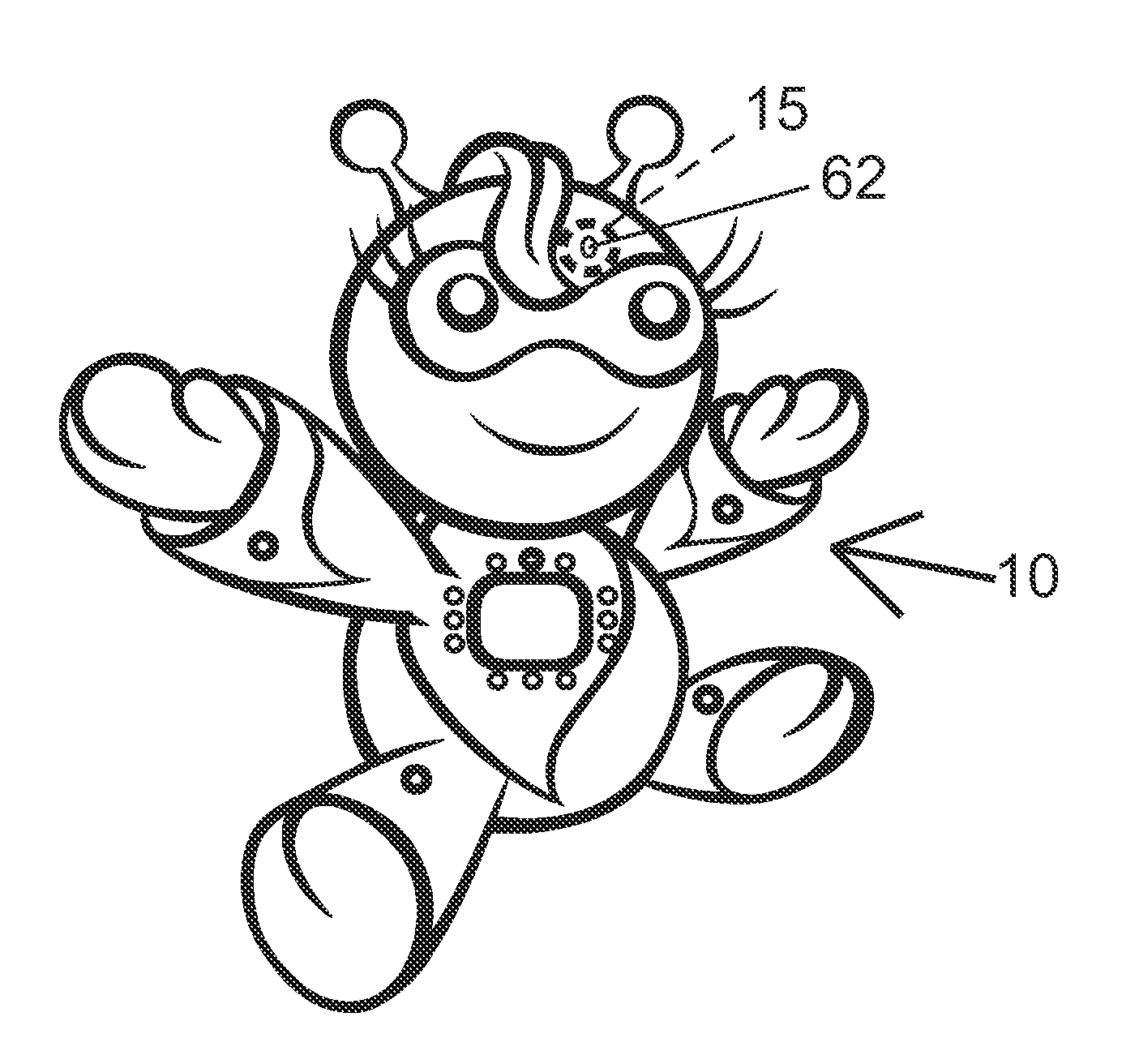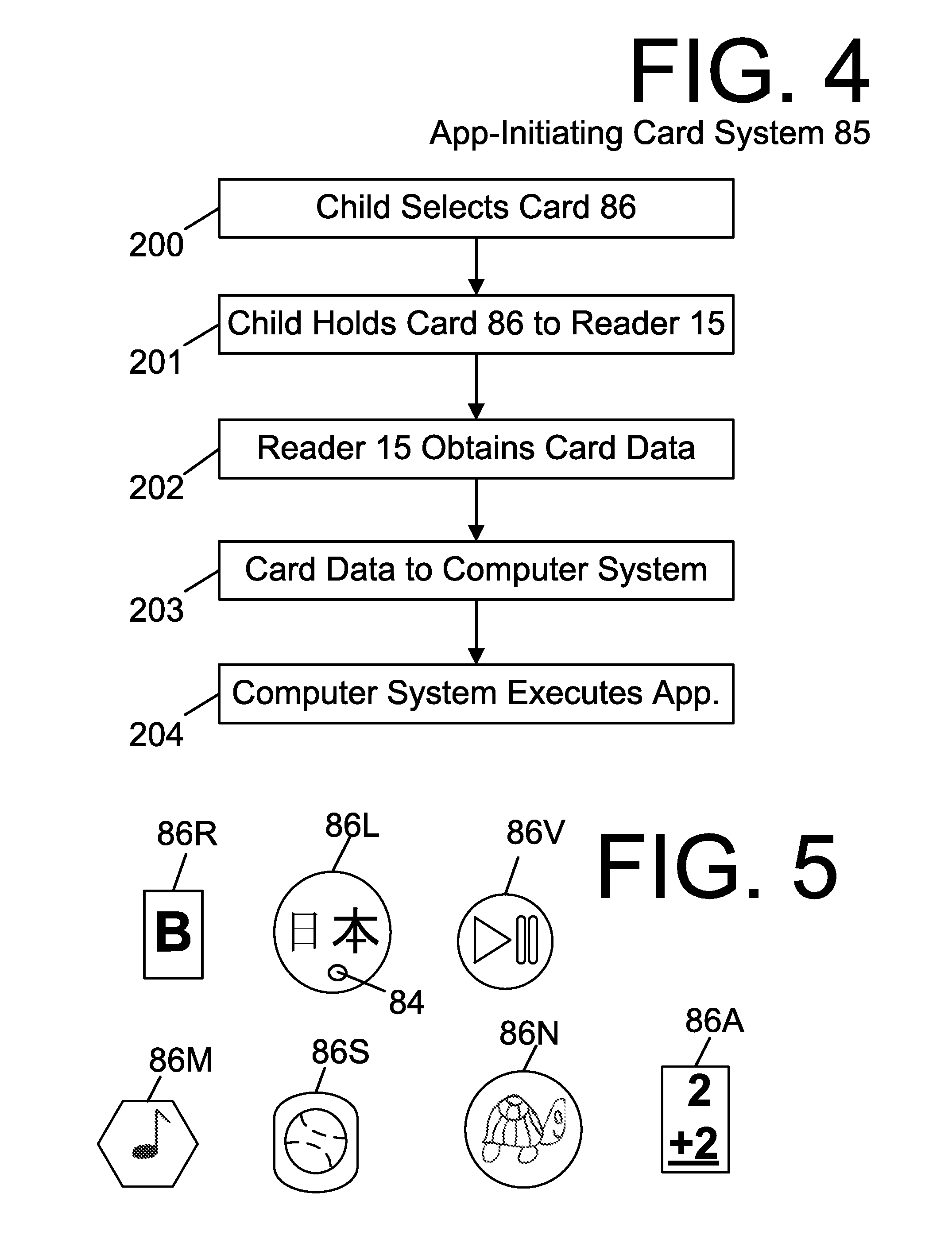Often the child can turn the toy on and turn the toy off, but has little control of the presentation of the activity or control over the actions the toy is programmed to perform—the toy carries out the pre-planned functions.
Nor can the child select which activity or action is to be performed.
Though children's
educational software is available that allows an
older child to use mouse and keyboard to control an activity, the computer-mouse-keyboard interface is not
usable by a younger child.
Also, some children do not have consistent access to a computer.
Some parents prefer not to allow the child to use a computer due to security concerns.
Some
software does not engage the child's attention or cannot be adjusted to meet the child's changing needs.
Many children's learning programs are not readily available to the parent or child, particularly compared to the quickly and easily available applications offered for immediate download in applications stores.
Additionally, a younger child who cannot read cannot execute an activity, which entails choosing a
CD ROM, inserting it appropriately into the computer and navigating through the displayed screen prompts to execute the selected activity; the child requires parental assistance.
Children like to make their own choices and control their own environment; yet currently available systems do not allow self-directed selection, control and execution of activities by the younger child.
Numerous monitoring and education / entertainment systems have been developed to assist the parent in meeting these goals, yet each is lacking in some feature or aspect.
For example, though monitoring alert systems can warn or alert a parent, they do not allow efficient real-time voice and video communication between the parent and child.
For instance, if the child is lost, a conventional GPS
alert system may notify the parent that the child has wandered off, but will not allow the parent to see there is a
picnic table beside the child and, then, to say to the child, “See the red
picnic table in front of you?
Though the parent in a nearby room is able to hear if a child calls out or cries, these systems are not designed to allow a remote parent (across town or across the country) to monitor a child.
Though some monitoring systems can be connected to a home network Internet connection to allow remote parental surveillance from an Internet-connected computer, the complicated setup involving
port forwarding and other advanced networking tweaks will deter many potential users—or will necessitate the expense of hiring a network
technician.
Additionally, these monitoring systems are one-way systems and do not allow two-way communication and interaction between the parent and the child.
For example, though the parent at his office computer may be able to see that the child at home is about to pull a pot of boiling water off the stove, he cannot give a real-time voice warning.
However, these GPS tracking devices do not provide efficient parent-child communication.
Plus, the child may not be cooperative, as wearing the wristband or carrying the tracking pod is troublesome without an apparent
gain from the child's point of view.
Additionally, this type of standalone
system adds yet another electronic device to the parent's collection of family electronic devices to manage, with inherent monetary costs and time costs (learning to use the device, keeping the device charged, maintaining the device and the like).
However, the device does not provide efficient communication between the parent and child, nor does it have entertainment or educational benefits.
Further, the size of the device must be minimized to be worn on the
wrist of a child so the size of the battery is small, necessitating frequent charging.
Young children cannot manage the complexities of cell phones that sometimes even challenge adult users.
Though the Chen phone uses the cellular system, it cannot be configured by the parent, except by the limited
text message function.
Certainly, the child cannot self-direct learning or entertainment, as the Chen phone does not incorporate learning or entertainment options for the child.
The Kikinis doll is substantially a computer interface designed for a child, but is limited in its lack of a method to allow the child to select programs, and by its limitation of computer
tethering.
Obtaining the correct equipment and setting up this networked situation may not be straightforward.
Additionally, this system requires an Internet connection and a means to connect to it, which are not always available.
Furthermore, the child cannot self-direct learning or entertainment.
Smart toys have attempted to address the desire for better children's educational systems, but the
modes of interaction between a child and the smart toy are not well developed.
The limits of this are obvious, however, as even adults suffer from extreme
frustration with automated voice answering systems that barely work.
Though the Huggable plush toy allows viewing, hearing and communicating with a child remotely and provides a means to connect remote relatives and teachers through
the Internet, it is tied to Internet
connectivity due to the real-time manipulation of the controls of the
robot, so cannot take
advantage of the benefits of cell phone
connectivity, such as a more developed and pervasive communication network, a different price structure, different communication capabilities, etc.
Additionally, it does not include security features and does not allow child-directed control or learning.
Yet conventional cell phones are not adapted to meet the needs of younger children; protocols are not developed to meet the needs of the child and parent.
Also, children cannot select the content they want nor execute the programs needed to deliver this content.
The large number of electronic devices normally owned increases
clutter and decreases optimum usage.
The
learning curve to use each one effectively often prevents efficient use.
Maintenance, keeping accessories located, and charging of the devices takes precious time from the parent.
 Login to View More
Login to View More  Login to View More
Login to View More 


